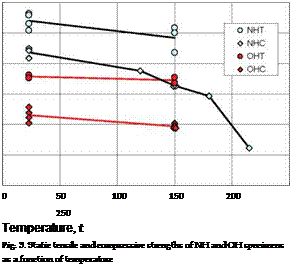Fig. 3 shows non-hole tensile (NHT) strength, non-hole compressive (NHC) strength, open – hole tensile (OHT) strength, and open-hole compressive (OHC) strength at RT and high temperatures, where OH strength is represented by net section stress, as described above. Since these tests were carried out to determine their temperature dependence, only a few specimens were tested for each case, as shown in Table 1. The relationship between static strength and temperature is represented by a solid line, which connects the mean strength at every test temperature. When there is only one test result, this value is taken as the mean. NHT strength at 150°C is slightly lower than that at RT. Although this fact is strongly influenced by the lowest value measured at 150°C (Fig. 3), this tendency is considered to be reasonable if referred to the tendency that appeared in OHT static strength (Fig. 3) and OHT fatigue strength, as described later. When the mean values are compared, the NHT strength at 150°C is 10% lower than that at RT. Since the usual allowable temperature limit of carbon fibers is about 538°C (1000°F) (Niu, 1996), the strength of carbon fibers in the material tested is considered unchanged between RT and 150°C. Furthermore, since all 0° fibers needs to be broken for the final failure of the material tested, the tensile strength is dominated by the fiber strength, i. e., it is considered to be a fiber-dominant property. However, the small decrease in tensile strength found at 150°C means that the matrix binding the fibers also has a small effect on tensile strength, so this is not entirely a fiber-dominant property. This aspect will be discussed in detail later on the basis of careful examination of failed specimens. On the other hand, the mean OHT strength at 150°C is only 3% lower than that at RT. Although this reduction is quite small in comparison with that of NHT strength, this tendency to decrease with increasing temperature is common for NHT and OHT strengths. NHC strength decreases considerably with increasing temperature and the mean NHC strength at 150°C is 25% lower than that at RT. Furthermore, although NHC strength drops gently up to 180°C, it drops heavily at 215°C. The compressive strength of both NH and OH specimens is considered to be a matrix-dominated property. Although this study did not measure the glass transition temperature of the material tested, Johnston and Gates reported
that the glass transition temperature of a G40-800/5260 CF/BMI composite was about 228°C after the material was left in a laboratory environment for several days (Johnston and Gates, 1998). Therefore, this heavy drop of the compressive strength of NH specimens is understandable. The decrease in NHC strength with temperature rise is considered to be a reflection of the decrease in matrix strength in that the specimen failure mechanism is not changed. The mean OHC strength at 150°C is 16% lower than that at RT and this drop is not very large, though it is larger than that of the mean OHT strength. The above results indicate that high temperatures have a large effect on NHC strength, but have a comparatively small effect on other strengths, i. e. NHT, OHT, and OHC strengths. The favorable test results mentioned above are considered to have appeared due to the effectiveness of using heat-resistant polymer as the matrix.
 1200
1200
1000
800 CL
600 O)
c
<D
400 200 0



